Abstract
The trends in leafy vegetables, especially spring lettuce, in Japanese agriculture are attracting attention. According to data for 2022, the national spring lettuce harvest was 111kt and the planted area was 3.93kha. Ibaraki prefecture boasted the largest shipment volume, achieving 31.7kt. This shows the importance of spring lettuce in Japanese agriculture. This figure also remains stable compared to historical trends, suggesting that spring lettuce demand and production are remaining within certain limits. Farmers and related industries are likely working to improve quality and efficiency while maintaining a balance between supply and demand. As a result, it can be said that Japan’s spring lettuce industry is growing on a stable foundation.
Spring lettuce harvest yield (main data).
Spring lettuce harvest volumes in Japanese agriculture have fluctuated from 1973 to 2022. The peak was recorded in 2002, when 125kt was recorded nationwide, but currently only 88.7% of that amount is harvested. During this time, spring lettuce yields are affected by many factors. For example, climate change, advances in agricultural technology, and changes in market demand. Agricultural policies and economic conditions also have an impact. As a general trend, harvest volumes fluctuate due to fluctuations in demand and improvements in production techniques. In recent years, the movement towards sustainable agriculture and local production for local consumption has been gaining momentum, influencing the production methods and distribution of spring lettuce. Farmers and their business partners are working hard to adapt to these changes and improve production efficiency. In the future, there will be a need to produce and supply spring lettuce sustainably while taking into account environmental considerations and changes in demand.
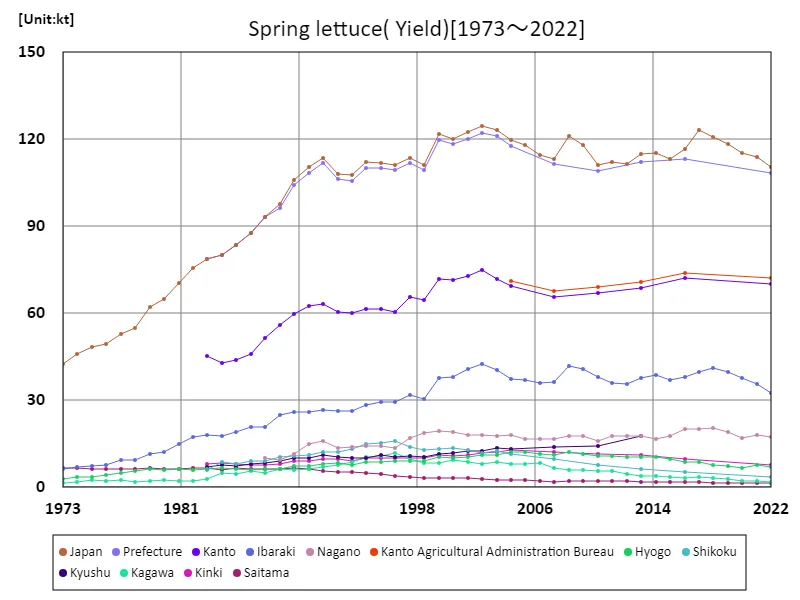

The maximum is 125kt[2002] of Japan, and the current value is about 88.7%
Spring lettuce harvest volume (by prefecture).
According to prefecture-by-prefecture data for 2022, Ibaraki Prefecture recorded the highest yield of leafy vegetable crops in Japanese agriculture at 32.6kt, the highest overall. This indicates that Ibaraki Prefecture plays a particularly important role in leafy vegetable production. It is believed that Ibaraki Prefecture’s abundant agricultural resources and climatic conditions contributed to this success. Other regions also boast high yields, indicating that leafy vegetable production is thriving throughout Japan. This increase is thought to be due to advances in agricultural technology, improvements in production methods, and the efforts of farmers. Furthermore, it is assumed that production is tailored to the characteristics and demand of each region, while also responding to changes in consumer demand and the market. Leafy vegetable production will continue to play an important role in promoting sustainable agriculture and revitalizing local economies.
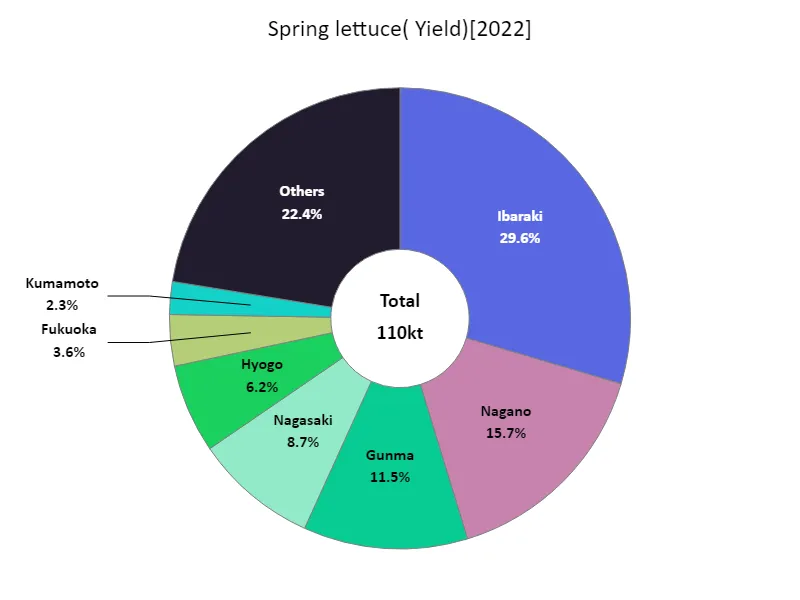

The maximum is 32.6kt of Ibaraki, the average is 2.4kt, and the total is 110kt
Spring lettuce planting area (main data).
The area planted to spring lettuce in Japanese agriculture fluctuates from 1973 to 2022. The peak was recorded in 1991 at 4.74kha nationwide, but currently 82.9% of that area is under cultivation. During this time, spring lettuce acreage has been affected by a variety of factors. For example, changing climatic conditions, agricultural policies, and fluctuations in market demand. Advances in agricultural technology and increased efficiency are also having an impact. As a general trend, the area under cultivation fluctuates in response to fluctuations in demand and changing economic conditions. In recent years, due to the movement towards local production and consumption and increased interest in food safety, the production of spring lettuce that takes advantage of regional characteristics has been promoted. There is also growing interest in sustainable agriculture and organic farming, and efforts are underway to expand the area under cultivation. Going forward, it will be necessary to continue to establish production systems that take environmental considerations into account and meet market needs.
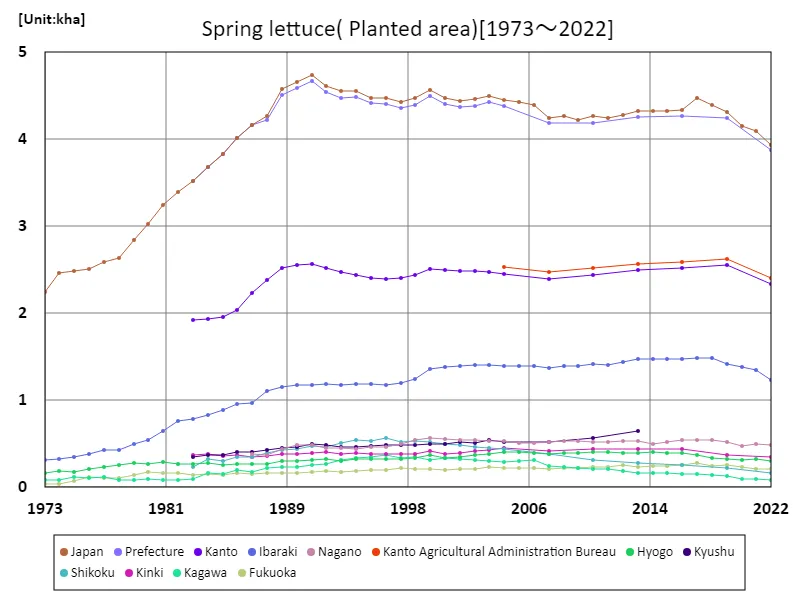

The maximum is 4.74kha[1991] of Japan, and the current value is about 82.9%
Spring lettuce cultivation area (by prefecture).
According to prefecture-by-prefecture data for 2022, Ibaraki Prefecture recorded the largest area planted to leafy vegetables in Japanese agriculture at 1.23 kha, making it the largest overall. It appears that Ibaraki Prefecture has a particular advantage in terms of the area planted with leafy vegetables. Ibaraki Prefecture has abundant agricultural resources and suitable climatic conditions, which are thought to lead to high productivity. Other regions are also working to produce leafy vegetables that take advantage of their own characteristics, and a variety of regions across Japan are contributing to the expansion of cultivated area. This increase is likely due to advances in agricultural technology, improvements in production methods, and the efforts of farmers. It is also assumed that production systems are adjusted to meet regional demand and market trends. In the future, it is expected that the production area of leafy vegetables will continue to expand, promoting sustainable agriculture and revitalizing the local economy.
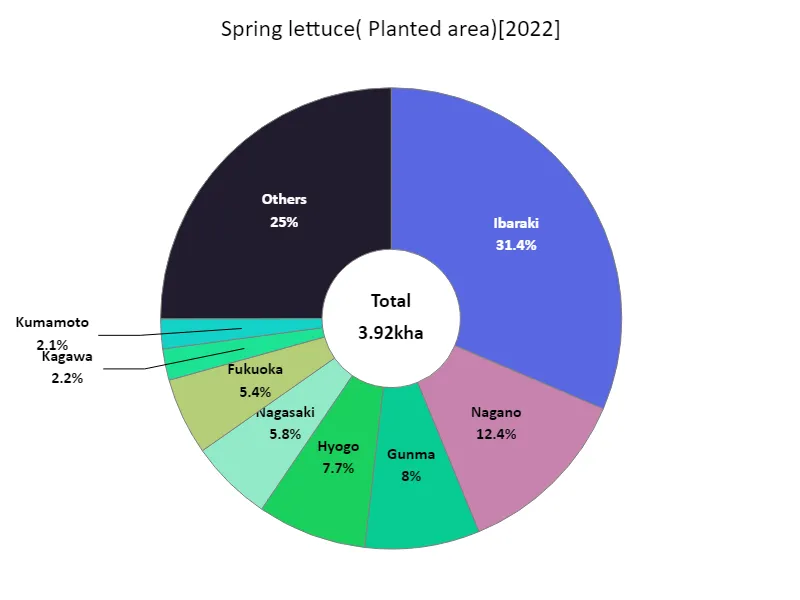

The maximum is 1.23kha of Ibaraki, the average is 85.1ha, and the total is 3.92kha
Spring lettuce shipment volume.
In 2022, the overall shipment volume of spring lettuce in Japanese agriculture was 104kt, with an average of 2.25kt. Ibaraki prefecture recorded the highest shipment volume, achieving 31.7kt. This indicates that Ibaraki Prefecture plays a central role in shipping spring lettuce. On the other hand, spring lettuce is also being shipped from other regions, suggesting that production is evenly distributed across the country. This figure is influenced by farmers’ efforts, technological innovations, and the effects of climatic conditions. In particular, Ibaraki Prefecture’s abundant agricultural resources and suitable climatic conditions are thought to contribute to its high productivity. Additionally, shipments tend to increase in the spring when demand for spring lettuce increases. In recent years, demand for safe and fresh spring lettuce has increased due to growing consumer interest in food safety and quality. As a result, farmers are striving to improve quality and production efficiency, which has led to increased production. In the future, the production and shipping volumes of spring lettuce are expected to continue to grow through the promotion of sustainable agriculture and local production and consumption. However, factors such as climate change and changes in market demand also require attention.
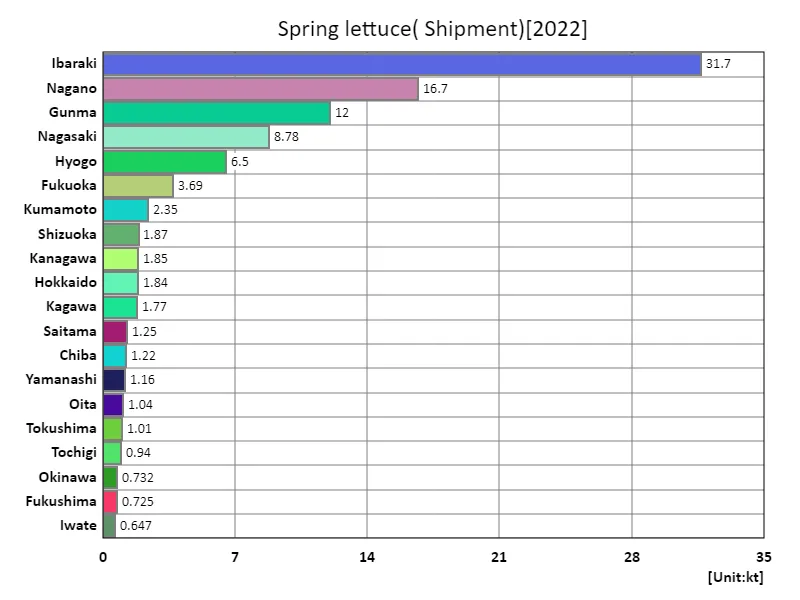

The maximum is 31.7kt of Ibaraki, the average is 2.25kt, and the total is 104kt
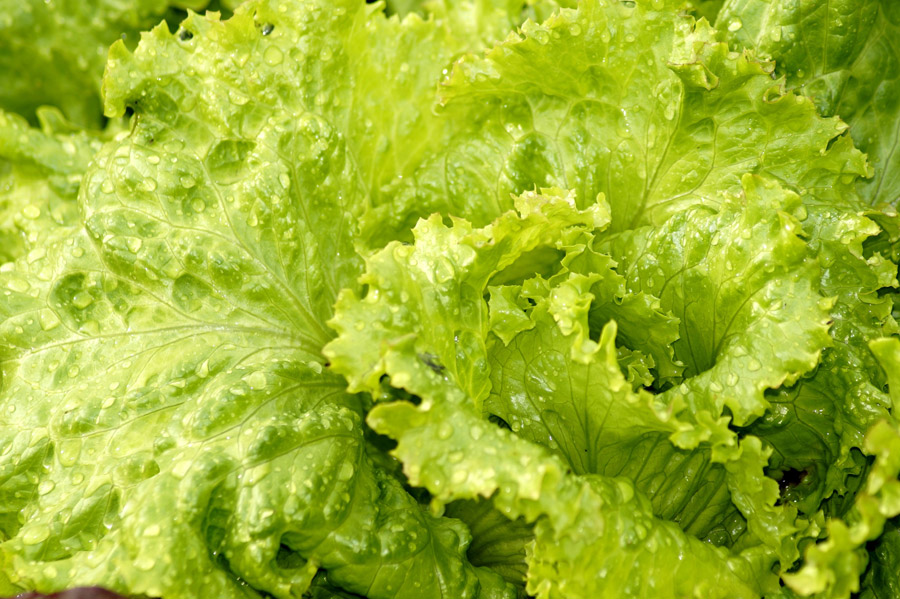


Comments